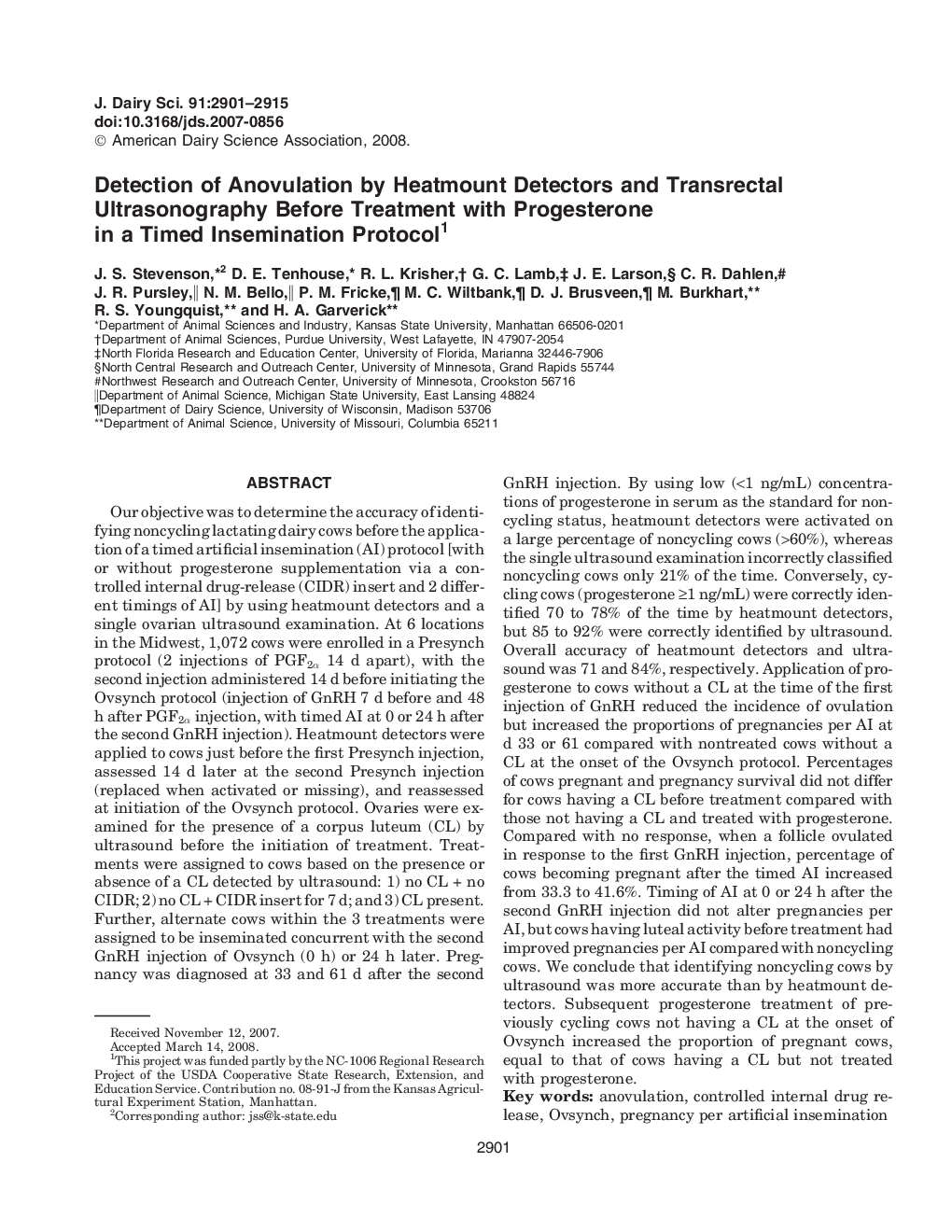| کد مقاله | کد نشریه | سال انتشار | مقاله انگلیسی | نسخه تمام متن |
|---|---|---|---|---|
| 2439930 | 1108107 | 2008 | 15 صفحه PDF | دانلود رایگان |

Our objective was to determine the accuracy of identifying noncycling lactating dairy cows before the application of a timed artificial insemination (AI) protocol [with or without progesterone supplementation via a controlled internal drug-release (CIDR) insert and 2 different timings of AI] by using heatmount detectors and a single ovarian ultrasound examination. At 6 locations in the Midwest, 1,072 cows were enrolled in a Presynch protocol (2 injections of PGF2α 14 d apart), with the second injection administered 14 d before initiating the Ovsynch protocol (injection of GnRH 7 d before and 48 h after PGF2α injection, with timed AI at 0 or 24 h after the second GnRH injection). Heatmount detectors were applied to cows just before the first Presynch injection, assessed 14 d later at the second Presynch injection (replaced when activated or missing), and reassessed at initiation of the Ovsynch protocol. Ovaries were examined for the presence of a corpus luteum (CL) by ultrasound before the initiation of treatment. Treatments were assigned to cows based on the presence or absence of a CL detected by ultrasound: 1) no CL + no CIDR; 2) no CL + CIDR insert for 7 d; and 3) CL present. Further, alternate cows within the 3 treatments were assigned to be inseminated concurrent with the second GnRH injection of Ovsynch (0 h) or 24 h later. Pregnancy was diagnosed at 33 and 61 d after the second GnRH injection. By using low (<1 ng/mL) concentrations of progesterone in serum as the standard for noncycling status, heatmount detectors were activated on a large percentage of noncycling cows (>60%), whereas the single ultrasound examination incorrectly classified noncycling cows only 21% of the time. Conversely, cycling cows (progesterone ≥1 ng/mL) were correctly identified 70 to 78% of the time by heatmount detectors, but 85 to 92% were correctly identified by ultrasound. Overall accuracy of heatmount detectors and ultrasound was 71 and 84%, respectively. Application of progesterone to cows without a CL at the time of the first injection of GnRH reduced the incidence of ovulation but increased the proportions of pregnancies per AI at d 33 or 61 compared with nontreated cows without a CL at the onset of the Ovsynch protocol. Percentages of cows pregnant and pregnancy survival did not differ for cows having a CL before treatment compared with those not having a CL and treated with progesterone. Compared with no response, when a follicle ovulated in response to the first GnRH injection, percentage of cows becoming pregnant after the timed AI increased from 33.3 to 41.6%. Timing of AI at 0 or 24 h after the second GnRH injection did not alter pregnancies per AI, but cows having luteal activity before treatment had improved pregnancies per AI compared with noncycling cows. We conclude that identifying noncycling cows by ultrasound was more accurate than by heatmount detectors. Subsequent progesterone treatment of previously cycling cows not having a CL at the onset of Ovsynch increased the proportion of pregnant cows, equal to that of cows having a CL but not treated with progesterone.
Journal: Journal of Dairy Science - Volume 91, Issue 7, July 2008, Pages 2901–2915